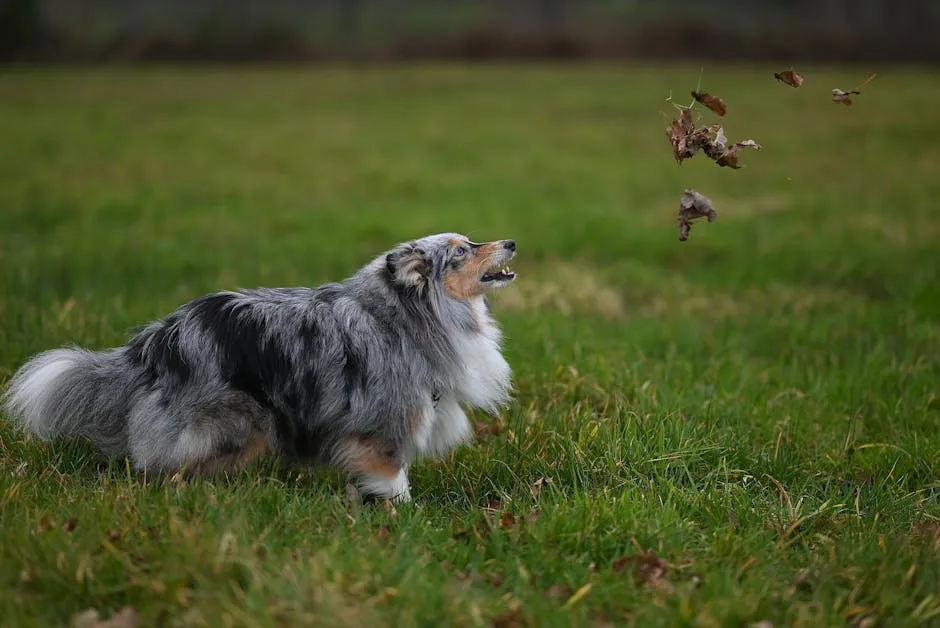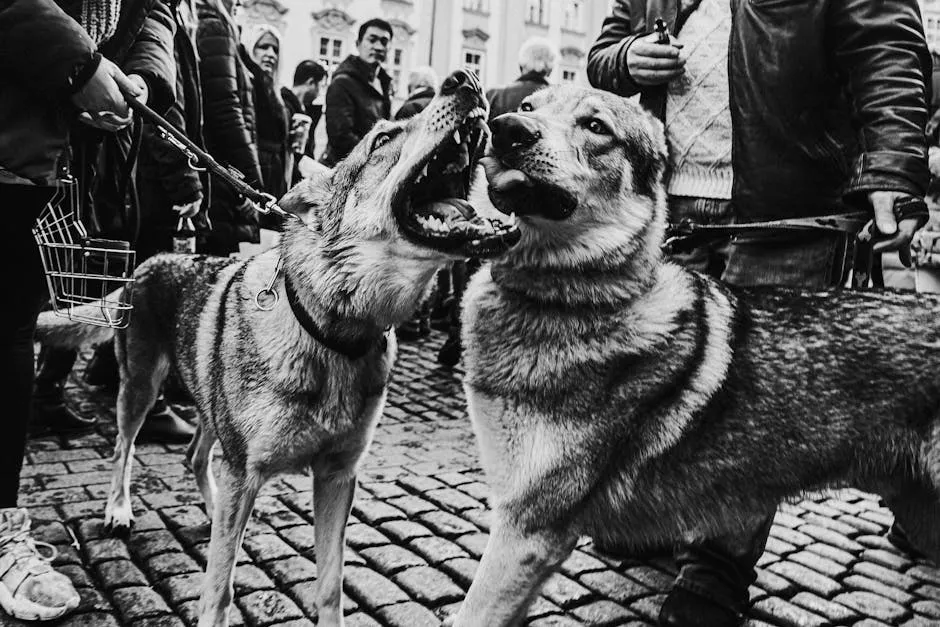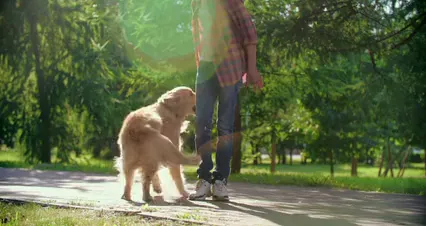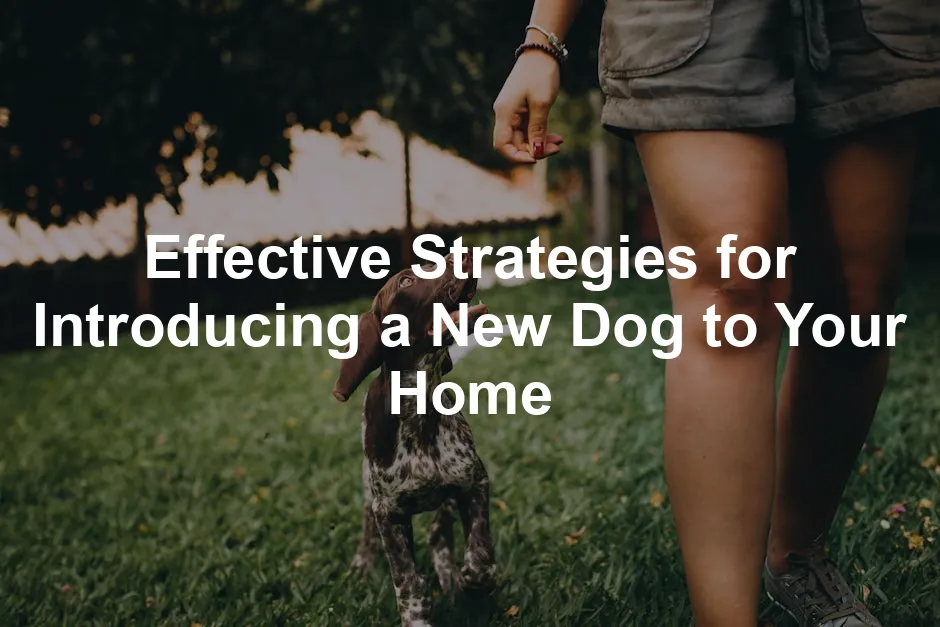On the flip side, look out for negative signals:
- Stiff Body: A rigid posture can suggest tension or aggression.
- Raised Hackles: Hair standing up on the back indicates arousal or fear.
- Baring Teeth: This is a clear sign of discomfort or a warning.
- Growling or Snapping: These sounds are red flags that indicate the need for immediate separation.
By being aware of these signals, you can ensure a safer introduction for both dogs. Quick reactions to body language can prevent conflicts and help build a positive relationship over time.
Tips for Successful Introductions
Successful introductions hinge on positive reinforcement and a calm atmosphere. First, use treats and praise generously during interactions. This encourages both dogs to associate each other with good experiences. Think of it as throwing a welcome party with tasty snacks!
Next, keep the first meetings calm and distraction-free. Choose a quiet place without loud noises or many other animals. A serene environment helps the dogs focus on each other without added stressors.
Start with short interactions, gradually increasing their time together as they grow more comfortable. This method ensures that both dogs can feel secure and relaxed. Remember, the goal is to create a welcoming space where both can thrive!

Integrating into the Home
Supervised Playtime
Supervised playtime is essential during the initial days of integration. Close supervision helps ensure that interactions remain positive and safe. Think of it as being a referee in a friendly match—keeping an eye on the game while ensuring everyone plays fair!
Here are some tips for managing playtime effectively:
- Limit Play Areas: Designate specific areas for play to reduce potential distractions and hazards. A fenced yard or a quiet room works wonders.
- Short Sessions: Start with short play sessions. If either dog shows signs of stress, it’s time for a break. It’s better to end on a good note!
- Use Toys Wisely: Provide plenty of toys to divert attention. This not only entertains them but also minimizes competition for resources.
- Separate When Needed: If things get too heated, separate the dogs and give them a chance to cool off. A little time apart can reset the mood.
By maintaining a close watch on their interactions, you foster a safe environment for both dogs. This careful management increases the chances of a lasting friendship as they learn to play and navigate their new world together.

Individual Spaces and Resources
When introducing a new dog to your home, individual spaces are vital. Giving each dog their own feeding areas, beds, and toys helps prevent resource guarding. Imagine a world where every dog feels secure, free from the stress of competition! Each dog should have their own designated spot to munch on kibble without side-eyeing the other. This approach reduces tension and makes mealtime a breeze.
Creating safe spaces is equally important. Dogs sometimes need a little alone time, especially when adjusting to a new environment. Designate cozy retreats where each dog can unwind, whether it’s a comfy bed in a quiet corner or a crate filled with their favorite toys. Think of it as their personal sanctuary—a place to chill when life gets a bit too hectic. You can also use dog blankets for added comfort!
Gradual Transition
Gradual transitions are key to a successful introduction. Start by allowing the dogs to spend time apart. This gives them a chance to acclimate to each other’s scents without direct interaction. It’s like a sneak peek before the grand reveal!
As they grow more comfortable, gradually increase their interactions. Short sessions work best at first. Think of it as a slow dance—take small steps before twirling into the spotlight. Encourage breaks during this process. Just like humans, dogs can feel overwhelmed, so a quick time-out can help them reset.

Addressing Challenges
What to Do If Tensions Arise
During introductions, watch for signs of discomfort and aggression. Dogs might express unease through growling, stiff bodies, or avoiding eye contact. If you notice these behaviors, it’s crucial to step in. You wouldn’t want to ignore a friend’s uneasy vibe, right?
If conflicts occur, separate the dogs immediately. A brief timeout allows both dogs to cool off and collect themselves. After a while, attempt to reintroduce them, but take it slow. Remember, patience is key.
Always prioritize safety over everything else. If behaviors escalate, don’t hesitate to consult a professional trainer. They can provide expert insights and strategies tailored to your dogs’ needs. With the right approach, even the most tense situations can transform into peaceful coexistence, leading to a fulfilling friendship between your pets.

Seeking Professional Help
Introducing a new dog to your home can be tricky. If challenges arise, don’t hesitate to seek professional help. Some dogs might need a little extra guidance to feel comfortable. A dog trainer or behaviorist can provide invaluable support. They can assess the situation and offer tailored strategies to ease the transition for everyone involved.
Finding the right professional is crucial. Look for trainers with positive reinforcement techniques. These methods create a safe and supportive environment for your furry friends. You can search for certified trainers through organizations like the Association of Professional Dog Trainers (APDT) or the International Association of Animal Behavior Consultants (IAABC). Referrals from friends or your vet can also point you in the right direction.
Remember, a little professional advice goes a long way. It’s a smart investment in your dogs’ happiness and well-being. So, if things aren’t going as planned, reach out for help!
Conclusion
In summary, introducing a new dog to your home takes time and patience. Start by creating a safe environment and gathering essential supplies. Establish a routine that works for both your new and existing pets. Gradual introductions can set the stage for a positive relationship.
Don’t forget to monitor body language. Understanding how each dog feels can prevent conflicts. If issues arise, seek professional help. Trainers can provide guidance tailored to your specific situation.
Remember, building a friendship between your new dog and existing pets is a process. With the right strategies in place, you can foster a rewarding relationship. Soon enough, your home will be filled with wagging tails and happy barks!
FAQs
How long does it usually take for a new dog to adjust to a new home?
Adjusting to a new environment can vary for each dog. The famous “3-3-3 Rule” is a great guideline. In the first three days, your new dog may be overwhelmed. They could hide or seem scared as they acclimate. By three weeks, they usually settle into their routine and start showing their personality. After three months, many dogs feel completely at home and secure.
What should I do if my current dog is aggressive towards the new dog?
If aggression occurs, prioritize safety. Separate the dogs immediately to prevent injury. Gradually reintroduce them in neutral territory, using leashes for control. Manage interactions by rewarding calm behavior with treats. If aggression continues, consult a professional trainer to develop a tailored plan to address the issue.
Can I introduce my new dog to my cat at the same time?
Introducing a new dog to your cat requires careful planning. Start by allowing them to get used to each other’s scents. Use a barrier, like a baby gate, for initial meetings. Keep the dog leashed and let the cat approach at their pace. Gradually increase exposure while monitoring their interactions. Remember, patience is key!
What should I do if my new dog is scared or anxious?
A scared dog needs reassurance. Create a safe space where they can retreat when feeling overwhelmed. Use soft voices and gentle movements to help them feel secure. Provide toys and engage in low-key activities to build confidence. Allow your dog to explore at their own pace, rewarding them with treats for bravery.
Is it necessary to have separate feeding areas for my dogs?
Yes, separate feeding areas can reduce competition and tension. Dogs may guard their food, leading to conflicts. By providing each dog with their own space for meals, you promote a calm atmosphere. This practice not only helps prevent squabbles but also ensures that each dog feels secure during mealtime.
Please let us know what you think about our content by leaving a comment down below!
Thank you for reading till here 🙂
Understanding and managing resource guarding in dogs is essential for a peaceful household. Understanding and managing resource guarding in dogs
All images from Pexels
Positive signals include:
- Relaxed Ears: Ears in a natural position indicate comfort.
- Wagging Tails: A wagging tail, especially if low and wide, shows excitement.
- Play Bow: Front legs stretched out while the rear remains up is an invitation to play.
- Soft Eyes: Relaxed eyes with no stiffness indicate a calm demeanor.
On the flip side, look out for negative signals:
- Stiff Body: A rigid posture can suggest tension or aggression.
- Raised Hackles: Hair standing up on the back indicates arousal or fear.
- Baring Teeth: This is a clear sign of discomfort or a warning.
- Growling or Snapping: These sounds are red flags that indicate the need for immediate separation.
By being aware of these signals, you can ensure a safer introduction for both dogs. Quick reactions to body language can prevent conflicts and help build a positive relationship over time.
Tips for Successful Introductions
Successful introductions hinge on positive reinforcement and a calm atmosphere. First, use treats and praise generously during interactions. This encourages both dogs to associate each other with good experiences. Think of it as throwing a welcome party with tasty snacks!
Next, keep the first meetings calm and distraction-free. Choose a quiet place without loud noises or many other animals. A serene environment helps the dogs focus on each other without added stressors.
Start with short interactions, gradually increasing their time together as they grow more comfortable. This method ensures that both dogs can feel secure and relaxed. Remember, the goal is to create a welcoming space where both can thrive!

Integrating into the Home
Supervised Playtime
Supervised playtime is essential during the initial days of integration. Close supervision helps ensure that interactions remain positive and safe. Think of it as being a referee in a friendly match—keeping an eye on the game while ensuring everyone plays fair!
Here are some tips for managing playtime effectively:
- Limit Play Areas: Designate specific areas for play to reduce potential distractions and hazards. A fenced yard or a quiet room works wonders.
- Short Sessions: Start with short play sessions. If either dog shows signs of stress, it’s time for a break. It’s better to end on a good note!
- Use Toys Wisely: Provide plenty of toys to divert attention. This not only entertains them but also minimizes competition for resources.
- Separate When Needed: If things get too heated, separate the dogs and give them a chance to cool off. A little time apart can reset the mood.
By maintaining a close watch on their interactions, you foster a safe environment for both dogs. This careful management increases the chances of a lasting friendship as they learn to play and navigate their new world together.

Individual Spaces and Resources
When introducing a new dog to your home, individual spaces are vital. Giving each dog their own feeding areas, beds, and toys helps prevent resource guarding. Imagine a world where every dog feels secure, free from the stress of competition! Each dog should have their own designated spot to munch on kibble without side-eyeing the other. This approach reduces tension and makes mealtime a breeze.
Creating safe spaces is equally important. Dogs sometimes need a little alone time, especially when adjusting to a new environment. Designate cozy retreats where each dog can unwind, whether it’s a comfy bed in a quiet corner or a crate filled with their favorite toys. Think of it as their personal sanctuary—a place to chill when life gets a bit too hectic. You can also use dog blankets for added comfort!
Gradual Transition
Gradual transitions are key to a successful introduction. Start by allowing the dogs to spend time apart. This gives them a chance to acclimate to each other’s scents without direct interaction. It’s like a sneak peek before the grand reveal!
As they grow more comfortable, gradually increase their interactions. Short sessions work best at first. Think of it as a slow dance—take small steps before twirling into the spotlight. Encourage breaks during this process. Just like humans, dogs can feel overwhelmed, so a quick time-out can help them reset.

Addressing Challenges
What to Do If Tensions Arise
During introductions, watch for signs of discomfort and aggression. Dogs might express unease through growling, stiff bodies, or avoiding eye contact. If you notice these behaviors, it’s crucial to step in. You wouldn’t want to ignore a friend’s uneasy vibe, right?
If conflicts occur, separate the dogs immediately. A brief timeout allows both dogs to cool off and collect themselves. After a while, attempt to reintroduce them, but take it slow. Remember, patience is key.
Always prioritize safety over everything else. If behaviors escalate, don’t hesitate to consult a professional trainer. They can provide expert insights and strategies tailored to your dogs’ needs. With the right approach, even the most tense situations can transform into peaceful coexistence, leading to a fulfilling friendship between your pets.

Seeking Professional Help
Introducing a new dog to your home can be tricky. If challenges arise, don’t hesitate to seek professional help. Some dogs might need a little extra guidance to feel comfortable. A dog trainer or behaviorist can provide invaluable support. They can assess the situation and offer tailored strategies to ease the transition for everyone involved.
Finding the right professional is crucial. Look for trainers with positive reinforcement techniques. These methods create a safe and supportive environment for your furry friends. You can search for certified trainers through organizations like the Association of Professional Dog Trainers (APDT) or the International Association of Animal Behavior Consultants (IAABC). Referrals from friends or your vet can also point you in the right direction.
Remember, a little professional advice goes a long way. It’s a smart investment in your dogs’ happiness and well-being. So, if things aren’t going as planned, reach out for help!
Conclusion
In summary, introducing a new dog to your home takes time and patience. Start by creating a safe environment and gathering essential supplies. Establish a routine that works for both your new and existing pets. Gradual introductions can set the stage for a positive relationship.
Don’t forget to monitor body language. Understanding how each dog feels can prevent conflicts. If issues arise, seek professional help. Trainers can provide guidance tailored to your specific situation.
Remember, building a friendship between your new dog and existing pets is a process. With the right strategies in place, you can foster a rewarding relationship. Soon enough, your home will be filled with wagging tails and happy barks!
FAQs
Please let us know what you think about our content by leaving a comment down below!
Thank you for reading till here 🙂
Understanding and managing resource guarding in dogs is essential for a peaceful household. Understanding and managing resource guarding in dogs
All images from Pexels
Introduction
Bringing a new dog home is a thrilling adventure filled with wagging tails and wet noses. However, it can also feel like trying to solve a Rubik’s cube blindfolded. The excitement of adopting a furry friend comes with challenges that require careful planning. A well-thought-out introduction ensures that both the new dog and your existing pets transition smoothly into a harmonious household.
A successful introduction can prevent future squabbles and help foster a positive bond between your new dog and current pets. Using effective strategies not only eases the adjustment period but also enhances the bonding experience. Think of it as setting the stage for a delightful new chapter in your family story, where everyone—two-legged and four-legged—can coexist happily.
Preparing for the New Arrival
Gather Essential Supplies
Before your new furry friend steps paw into your home, gather essential supplies. Think of a leash, dog bed, food and water bowls, and a few toys. Having these items ready beforehand sets a welcoming tone for your new pet. It’s like preparing the perfect welcome basket for a houseguest.
A cozy bed gives your dog a sense of security, while toys keep boredom at bay. Don’t forget treats! These tasty morsels are great for rewarding good behavior and building trust. By ensuring everything is in place, you make your home a safe haven for your new companion as they begin their journey with you.
Create a Safe Environment
Creating a safe environment is crucial for your new dog. Puppy-proof your home by securing hazardous items. Think of it as dog-proofing for dummies—move sharp objects, hide electrical cords, and stash away cleaning supplies. This precaution prevents accidents and ensures a stress-free transition.
Additionally, designate a comfortable space just for your new dog. This area should be quiet and away from the hustle and bustle of family life. A safe retreat helps your dog feel secure while they adjust to their new surroundings. Imagine how comforting it would be to have a cozy corner to curl up in when everything around you is new and overwhelming. Consider adding a dog crate for that extra layer of comfort!
With these preparations, you’re not only ensuring your new dog’s safety but also paving the way for a smooth introduction to their new home.
Establish a Routine
Establishing a routine is vital for your new dog. Dogs thrive on consistency. A predictable schedule for feeding, walks, and playtime helps reduce anxiety. Think of it as creating a doggy calendar that everyone can follow.
Start with feeding times. Set specific meal hours and stick to them. This teaches your dog when to expect food and can help prevent begging or scavenging. Next up—potty breaks! Regular bathroom outings keep accidents at bay and reinforce good habits.
Now let’s talk walks. Dogs need physical activity. Designate times for walks that suit your schedule. A daily walk not only helps your dog burn off energy but also allows them to explore their new environment. Don’t forget to use a sturdy dog harness to keep them secure and comfortable!
Playtime is equally important. Set aside moments where you can engage in fun activities. Whether it’s tug-of-war or fetch, these interactions strengthen your bond. Use different toys to keep things interesting. Rotate them regularly to keep your dog guessing!
For existing pets, ensure the routine includes them too. This prevents feelings of jealousy or neglect. Involve your current pets in the new dog’s routine. Maybe they join in for walks or share playtime. Everyone gets to be part of the fun.
By establishing a consistent routine, you create a sense of security. Both your new and existing pets will appreciate the structure. It’s not just about feeding and walks; it’s about building a happy, balanced household where everyone knows what’s coming next.

The Introduction Process
Initial Meeting: Setting the Stage
Choose a Neutral Location
When introducing dogs, a neutral location is key. Think of it as a first date—no one wants to meet their partner at home, where they might feel territorial. A park or quiet street provides a relaxed atmosphere. This helps both dogs feel less anxious. They can explore and get to know each other without the pressure of defending their turf.
Leash Management
Using leashes during introductions is essential. However, keep them loose. Tight leashes can create tension. It’s like holding your breath; you want to stay relaxed. Allow both dogs to move freely while still maintaining control. If they’re too close, use treats to guide them apart. This way, you can encourage calm behavior and positive interactions.
Gradual Introductions
Scent Swapping
Before the big meeting, start with scent swapping. Allow each dog to sniff a blanket or toy that belongs to the other. This familiarizes them with each other’s scent in a non-threatening way. It’s like showing them a friend’s photo before they meet in person.
Short Supervised Interactions
When the time comes for their first meeting, keep it short. Allow them to interact for just a few minutes at first. Monitor their body language closely. If either dog shows signs of stress, separate them. Gradually increase the time they spend together as they become more comfortable. This slow approach helps build trust and reduces the risk of conflict.
By following these steps, you can create a friendly environment for both dogs. Each interaction is a building block toward a positive relationship. With patience and care, they can become the best of friends!

Observing Body Language
When introducing dogs, monitoring their body language is crucial. Dogs communicate primarily through their posture, facial expressions, and movements. Understanding these signals can help you identify stress or aggression before things escalate.
Positive signals include:
- Relaxed Ears: Ears in a natural position indicate comfort.
- Wagging Tails: A wagging tail, especially if low and wide, shows excitement.
- Play Bow: Front legs stretched out while the rear remains up is an invitation to play.
- Soft Eyes: Relaxed eyes with no stiffness indicate a calm demeanor.
On the flip side, look out for negative signals:
- Stiff Body: A rigid posture can suggest tension or aggression.
- Raised Hackles: Hair standing up on the back indicates arousal or fear.
- Baring Teeth: This is a clear sign of discomfort or a warning.
- Growling or Snapping: These sounds are red flags that indicate the need for immediate separation.
By being aware of these signals, you can ensure a safer introduction for both dogs. Quick reactions to body language can prevent conflicts and help build a positive relationship over time.
Tips for Successful Introductions
Successful introductions hinge on positive reinforcement and a calm atmosphere. First, use treats and praise generously during interactions. This encourages both dogs to associate each other with good experiences. Think of it as throwing a welcome party with tasty snacks!
Next, keep the first meetings calm and distraction-free. Choose a quiet place without loud noises or many other animals. A serene environment helps the dogs focus on each other without added stressors.
Start with short interactions, gradually increasing their time together as they grow more comfortable. This method ensures that both dogs can feel secure and relaxed. Remember, the goal is to create a welcoming space where both can thrive!

Integrating into the Home
Supervised Playtime
Supervised playtime is essential during the initial days of integration. Close supervision helps ensure that interactions remain positive and safe. Think of it as being a referee in a friendly match—keeping an eye on the game while ensuring everyone plays fair!
Here are some tips for managing playtime effectively:
- Limit Play Areas: Designate specific areas for play to reduce potential distractions and hazards. A fenced yard or a quiet room works wonders.
- Short Sessions: Start with short play sessions. If either dog shows signs of stress, it’s time for a break. It’s better to end on a good note!
- Use Toys Wisely: Provide plenty of toys to divert attention. This not only entertains them but also minimizes competition for resources.
- Separate When Needed: If things get too heated, separate the dogs and give them a chance to cool off. A little time apart can reset the mood.
By maintaining a close watch on their interactions, you foster a safe environment for both dogs. This careful management increases the chances of a lasting friendship as they learn to play and navigate their new world together.

Individual Spaces and Resources
When introducing a new dog to your home, individual spaces are vital. Giving each dog their own feeding areas, beds, and toys helps prevent resource guarding. Imagine a world where every dog feels secure, free from the stress of competition! Each dog should have their own designated spot to munch on kibble without side-eyeing the other. This approach reduces tension and makes mealtime a breeze.
Creating safe spaces is equally important. Dogs sometimes need a little alone time, especially when adjusting to a new environment. Designate cozy retreats where each dog can unwind, whether it’s a comfy bed in a quiet corner or a crate filled with their favorite toys. Think of it as their personal sanctuary—a place to chill when life gets a bit too hectic. You can also use dog blankets for added comfort!
Gradual Transition
Gradual transitions are key to a successful introduction. Start by allowing the dogs to spend time apart. This gives them a chance to acclimate to each other’s scents without direct interaction. It’s like a sneak peek before the grand reveal!
As they grow more comfortable, gradually increase their interactions. Short sessions work best at first. Think of it as a slow dance—take small steps before twirling into the spotlight. Encourage breaks during this process. Just like humans, dogs can feel overwhelmed, so a quick time-out can help them reset.

Addressing Challenges
What to Do If Tensions Arise
During introductions, watch for signs of discomfort and aggression. Dogs might express unease through growling, stiff bodies, or avoiding eye contact. If you notice these behaviors, it’s crucial to step in. You wouldn’t want to ignore a friend’s uneasy vibe, right?
If conflicts occur, separate the dogs immediately. A brief timeout allows both dogs to cool off and collect themselves. After a while, attempt to reintroduce them, but take it slow. Remember, patience is key.
Always prioritize safety over everything else. If behaviors escalate, don’t hesitate to consult a professional trainer. They can provide expert insights and strategies tailored to your dogs’ needs. With the right approach, even the most tense situations can transform into peaceful coexistence, leading to a fulfilling friendship between your pets.

Seeking Professional Help
Introducing a new dog to your home can be tricky. If challenges arise, don’t hesitate to seek professional help. Some dogs might need a little extra guidance to feel comfortable. A dog trainer or behaviorist can provide invaluable support. They can assess the situation and offer tailored strategies to ease the transition for everyone involved.
Finding the right professional is crucial. Look for trainers with positive reinforcement techniques. These methods create a safe and supportive environment for your furry friends. You can search for certified trainers through organizations like the Association of Professional Dog Trainers (APDT) or the International Association of Animal Behavior Consultants (IAABC). Referrals from friends or your vet can also point you in the right direction.
Remember, a little professional advice goes a long way. It’s a smart investment in your dogs’ happiness and well-being. So, if things aren’t going as planned, reach out for help!
Conclusion
In summary, introducing a new dog to your home takes time and patience. Start by creating a safe environment and gathering essential supplies. Establish a routine that works for both your new and existing pets. Gradual introductions can set the stage for a positive relationship.
Don’t forget to monitor body language. Understanding how each dog feels can prevent conflicts. If issues arise, seek professional help. Trainers can provide guidance tailored to your specific situation.
Remember, building a friendship between your new dog and existing pets is a process. With the right strategies in place, you can foster a rewarding relationship. Soon enough, your home will be filled with wagging tails and happy barks!
FAQs
Please let us know what you think about our content by leaving a comment down below!
Thank you for reading till here 🙂
Understanding and managing resource guarding in dogs is essential for a peaceful household. Understanding and managing resource guarding in dogs
All images from Pexels





